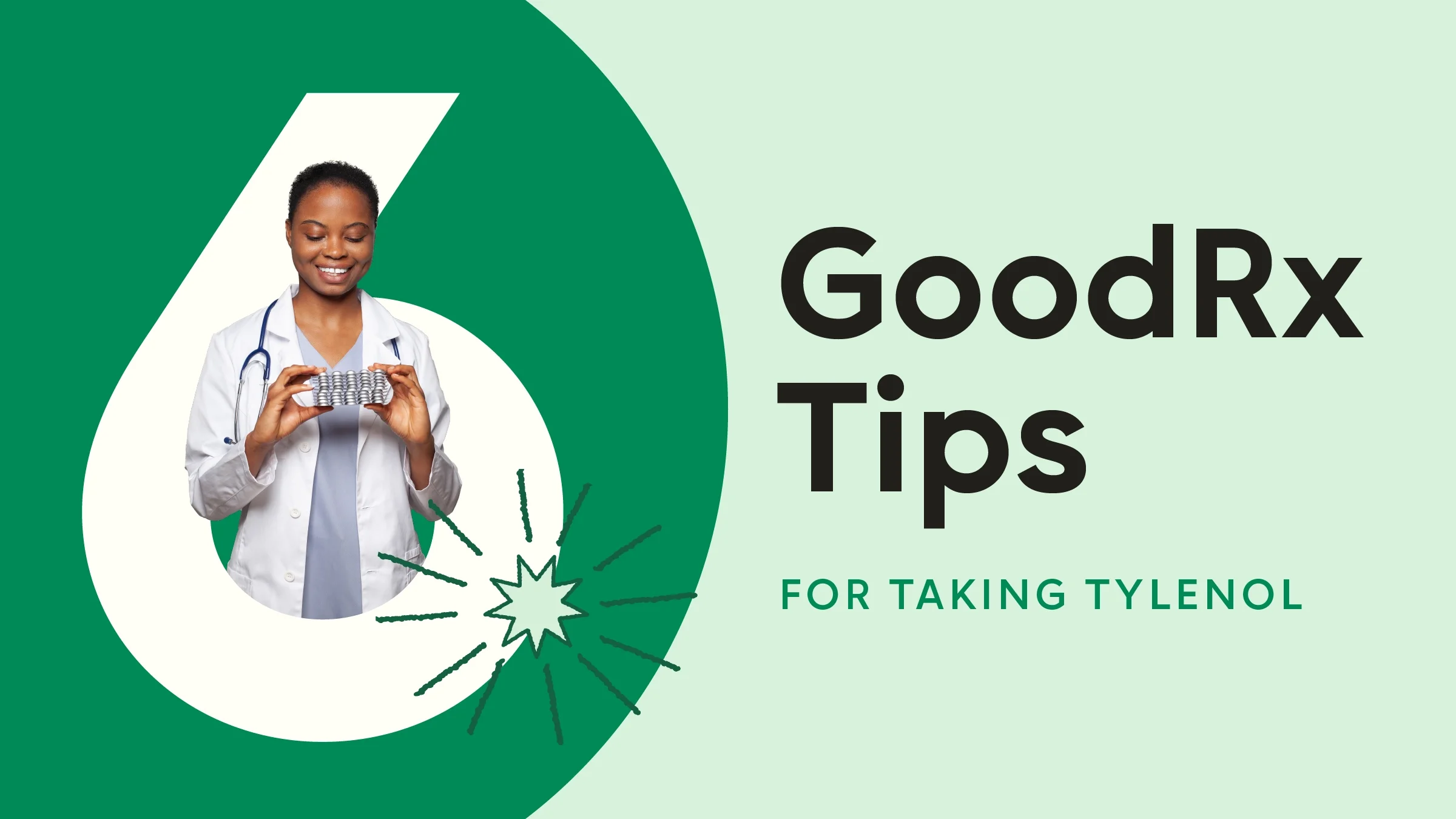Key takeaways:
Tylenol (acetaminophen) is a medication that helps manage pain and fever in adults and kids. It’s available in many over-the-counter (OTC) products, and it’s also found in some prescription pain medications.
Tylenol works relatively fast to treat pain and fever. The oral forms of Tylenol are most common, and they typically start working within 15 to 60 minutes.
Check the “Drug Facts” label for dosage instructions before taking any OTC medication for pain or fever. This helps ensure you don’t take too much Tylenol. It’s also best to keep Tylenol out of reach from kids and pets to prevent accidental ingestion.
Save on related medications
Tylenol (acetaminophen) is likely a medication you keep on hand at home or while you travel. It’s a pain- and fever-reducing medication found in over 600 over-the-counter (OTC) and prescription pain products. It’s widely available as a generic and brand-name medication for adults and kids. You can find it in several stand-alone products and combination cough-and-cold medications.
When taken at the recommended dose, Tylenol is considered to be a safe, first-choice medication for treating mild-to-moderate pain. And while it starts to work relatively quickly to relieve pain or fever, the specific timeframe can vary depending on what form of Tylenol you’re taking.
When weighing which form to pick up at the pharmacy, it would help to know how long Tylenol takes to work, whether it be an oral pill or dissolvable tablet. Here, we’ll offer tips on timing your doses and how else to get the most out of the medication.
1. Know how long different Tylenol dosage forms take to work
Tylenol works swiftly to help reduce pain and fever. It does so by blocking certain chemicals in the brain.
In general, the oral forms of Tylenol take up to 60 minutes to start working. But the effervescent (dissolving) tablets and powder packs may work faster — taking about 20 minutes or less to kick in. However, specific timeframes may vary from person to person.
Check out the table below for a guide that breaks it down by Tylenol formulation.
Tylenol formulation | How long does it take to kick in? | How long does it last? |
|---|---|---|
15-60 minutes | 4-6 hours | |
Effervescent (dissolvable) tablets and powder packs | 20 minutes | 4-6 hours |
15-60 minutes | 4-6 hours | |
Pain: 5-10 minutes Fever: 30 minutes | 4-6 hours | |
Oral Tylenol suspension (liquid) | 15-60 minutes | 4-6 hours |
Good to know: While times vary, one form of Tylenol isn’t considered better than the rest. All available dosage forms provide a similar benefit for treating pain and fever.
2. You can take Tylenol on an empty stomach
You can take oral Tylenol with or without food. But taking Tylenol on an empty stomach may help it work slightly faster. Food aside, you should take Tylenol with a full glass of water.
When it comes to Tylenol suppositories and IV Tylenol, food and water don’t make a difference.
3. Tylenol interacts with certain medications (and alcohol)
You don’t need to separate Tylenol from any medications throughout the day. But several medications can still interact with Tylenol. These interactions can raise the risk of experiencing side effects.
For instance, if you take the blood thinner warfarin (Coumadin, Jantoven), your prescriber may want to monitor your blood work more closely if you take Tylenol frequently. Tylenol can enhance warfarin’s effects, so the combination could raise your risk of bleeding.
Tylenol is also known to be tough on your liver. Certain medications can raise the risk of developing liver problems when taken with Tylenol, such as:
A strategic overview: Learn from pharmacists about how Tylenol (acetaminophen) works to relieve pain and fever.
Tylenol intake: Pharmacists review the safe amount of Tylenol infants, kids, and adults can take each day.
Risk management: Learn about possible Tylenol side effects, how to identify them, and when to get emergency medical care.
Alcohol also affects your liver, so drinking in moderation is important. This is especially true if you take Tylenol frequently. It’s best to limit alcoholic beverages to one drink for women and two for men each day. The combination of alcohol and Tylenol could potentially cause liver damage.
Keeping a current list of your OTC and prescription medications can be helpful for your pharmacist or prescriber to check for any interactions.
4. Serious side effects are generally preventable
Tylenol is generally well-tolerated. The most common Tylenol side effects are nausea and headache, but these are rare. It also causes fewer stomach-related side effects than nonsteroidal anti-inflammatory drugs (NSAIDs), such as ibuprofen (Advil, Motrin) and naproxen (Aleve, Naprosyn).
Serious side effects from Tylenol are also possible, albeit rare. It has the potential to cause liver damage and severe skin rashes. Possible signs and symptoms of liver damage include vomiting, stomach pain, and low blood pressure. Serious skin rash symptoms may include skin reddening, sores, and blisters.
If you experience symptoms of any serious side effects, stop taking Tylenol. Contact your healthcare professional for guidance as soon as you can. But if your symptoms feel severe, seek emergency medical care right away.
5. Taking too much Tylenol can be harmful
For most people, taking more than 4,000 mg of Tylenol in a 24-hour period is too much. But if you have liver problems or take certain medications that interact with Tylenol, your maximum recommended daily dose may be lower. Your pharmacist and prescriber can tell you how much Tylenol is safe for you to take.
Keep in mind that this cutoff includes Tylenol from all sources. A variety of combination products, such as Excedrin Migraine (acetaminophen / aspirin / caffeine), also contain Tylenol. Always read the “Drug Facts” label on OTC products before taking them. This helps make sure you aren’t accidentally taking multiple Tylenol-containing products at the same time. Keep in mind many labels will likely list the active ingredient “acetaminophen” rather than Tylenol.
Certain prescription pain medications also contain Tylenol. Acetaminophen / codeine and Percocet (oxycodone / acetaminophen) are two common ones. It’s best to steer clear of any OTC Tylenol products while taking prescription ones to avoid taking too much. To help mark medications that contain acetaminophen, the abbreviation “APAP” may appear on the prescription label.
If you think you or a loved one have taken too much Tylenol, reach out to your healthcare professional right away. You can also contact Poison Control online or at 1-800-222-1222. They can advise you on the next steps depending on how much Tylenol was taken. Sometimes, medical treatment in a hospital is needed to prevent liver damage.
6. Tylenol should be stored and disposed of safely
It’s a scary situation if your child or pet accidentally ingests Tylenol. Thankfully, there are ways to prevent this from happening.
Always keep Tylenol in its original child-resistant packaging. You should also store it in a cabinet or other area that is locked and out of reach of kids and pets. After taking a dose of Tylenol or giving it to your child, make sure to put the medication bottle away right away.
If you’re finished with a prescription pain medication that contains Tylenol (or your OTC product is expired), proper disposal is a recommended next step. Drug take-back locations are the best way to dispose of medications.
Tips on how to save money on your Tylenol prescription
There are ways to save on Tylenol, which is available as both a brand-name and generic medication. If you receive a prescription for OTC Tylenol, GoodRx can help you save. Generic Tylenol’s price at certain pharmacies is as low as $2.61 with a free GoodRx coupon. Tylenol’s manufacturer also offers a coupon for brand-name Tylenol products.
The bottom line
Tylenol (acetaminophen) is widely available in a variety of over-the-counter (OTC) and prescription products to manage pain and fever. It typically starts working quickly to relieve symptoms. Most oral Tylenol forms kick in within 15 to 60 minutes. Side effects are usually mild. But if you experience symptoms of liver damage or a skin rash, reach out to your healthcare professional right away. Make sure not to double up on Tylenol products to prevent taking too much.

Why trust our experts?



References
Agrawal, S., et al. (2025). Acetaminophen toxicity. StatPearls.
Amaechi, O., et al. (2021). Pharmacologic therapy for acute pain. American Family Physician.
FeverAll. (n.d.). Frequently asked questions.
Gerriets, V., et al. (2024). Acetaminophen. StatPearls.
Kenvue Brands. (2025). Infants Tylenol- acetaminophen suspension [package insert].
KnowYourDose.org. (n.d.). Acetaminophen dosing calculator. Acetaminophen Awareness Coalition.
KnowYourDose.org. (n.d.). Get the facts about acetaminophen. Acetaminophen Awareness Coalition.
Lopes, R. D., et al. (2011). Warfarin and acetaminophen interaction: A summary of the evidence and biologic plausibility. Blood.
Møller, P. L., et al. (2013). Time to onset of analgesia and analgesic efficacy of effervescent acetaminophen 1000 mg in postoperative dental pain: A single-dose, double-blind, randomized, placebo-controlled study. The Journal of Clinical Pharmacology.
Moore, R. A., et al. (2015). Effects of food on pharmacokinetics of immediate release oral formulations of aspirin, dipyrone, paracetamol and NSAIDs - a systematic review. British Journal of Clinical Pharmacology.
Sobieraj, D. M., et al. (2019). Introduction. Comparative Effectiveness of Analgesics To Reduce Acute Pain in the Prehospital Setting. Agency for Healthcare Research and Quality.
Twycross, R., et al. (2013). Acetaminophen (paracetamol). Journal of Pain and Symptom Management.
U.S. Food and Drug Administration. (2024). FDA issues agency-initiated proposed order, regarding OTC monograph drugs containing acetaminophen.
U.S. Food and Drug Administration. (2024). The over-the-counter drug facts label.

















